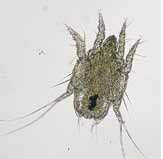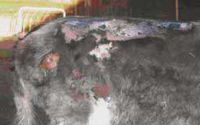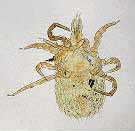Mange - Donkey



Introduction
Chorioptes, Psoroptes, Sarcoptes and Demodex mites may be found in donkeys as they are in horses, but little information is available on their prevalence in donkeys. Chorioptes spp. commonly infest donkeys over winter months in particular and although pruritus is a prominent sign it can be almost insignificant.
Clinical signs
Mites are rarely seen at The Donkey Sanctuary but should be considered in the differential diagnosis of any skin condition producing hair loss, irritation, thickened skin with scabs and exudate.
- Chorioptic mange may infest donkeys during winter and in severe infestation self trauma may occur due to the pruritus
- A hypersensitivity may develop in which the extent of cutaneous inflammation is far worse than the condition warrants
Diagnosis
A diagnosis of mite infestation is reliant on finding and identifying the parasites. Skin brushings are far better than scrapings because cases of sarcoptes or demodex infection (the only significant burrowing mites in donkeys) are singularly rare. It is important to realise that the severity of the pruritus or the extent of skin lesions does not indicate the number of parasites present in all cases. Some will have little evidence of heavy infestations and others will have severe signs from few. This means that it is sometimes difficult to confirm the diagnosis. Skin brushings collected into a transparent glass or plastic pot and viewed on a dark surface with a magnifying glass are easily obtained and actually harvest the parasites from a wide area.
Skin scrapings are largely valueless – Sarcoptes spp. and Demodex spp. parasites are the only burrowing mites and these are exceedingly rare.
Identification of the parasite involved is important because it gives an idea of the epidemiology of the case and the treatment options.
Treatment
Treatment involves repeated application of parasiticidal washes containing either a synthetic pyrethroid or fipronil. However, these are only partially effective, and concurrent management to avoid further infestations and treatment of in-contact affected donkeys is important. The use of avermectin rinse solutions can be helpful.
- Pour-on preparations - as for lice
- Ivermectin may be used to treat sarcoptic, psoroptic and chorioptic mange. Repeat dose three times at intervals of two weeks
Literature Search
Use these links to find recent scientific publications via CAB Abstracts (log in required unless accessing from a subscribing organisation).
Mange in donkeys related publications
References
- Knottenbelt, D. (2008) Skin disorders In Svendsen, E.D., Duncan, J. and Hadrill, D. (2008) The Professional Handbook of the Donkey, 4th edition, Whittet Books, Chapter 8
- Trawford, A. and Getachew, M. (2008) Parasites In Svendsen, E.D., Duncan, J. and Hadrill, D. (2008) The Professional Handbook of the Donkey, 4th edition, Whittet Books, Chapter 6
|
|
This section was sponsored and content provided by THE DONKEY SANCTUARY |
|---|
